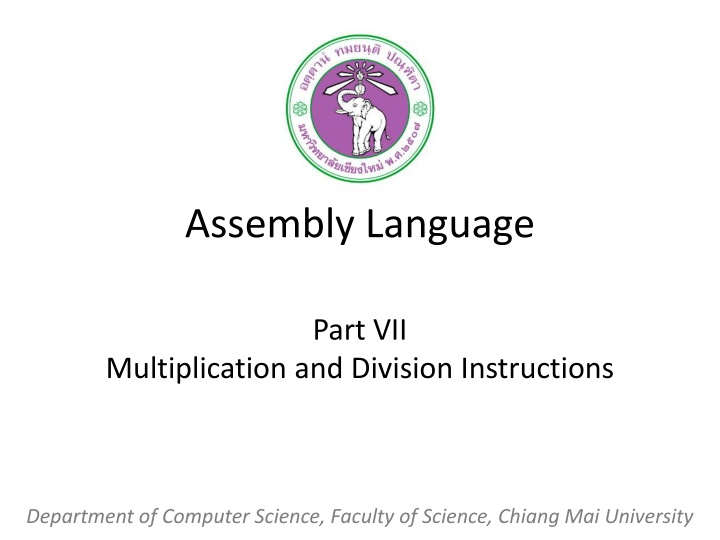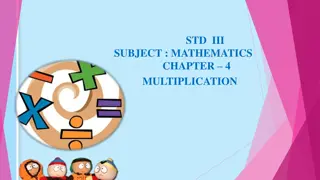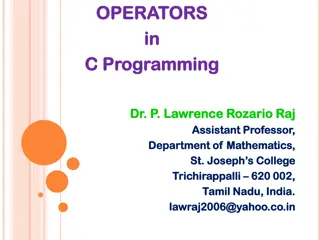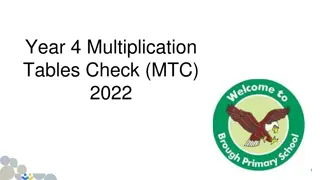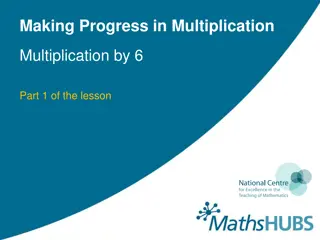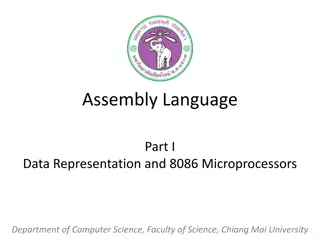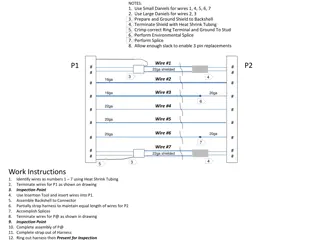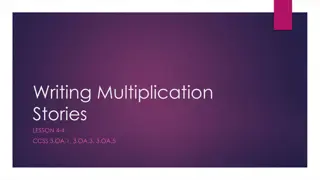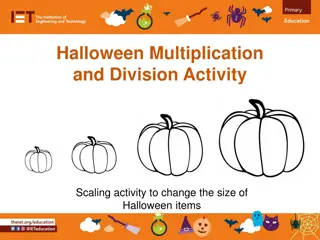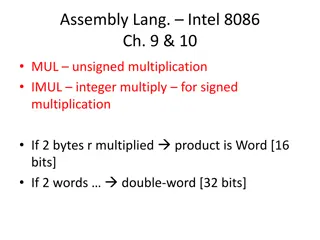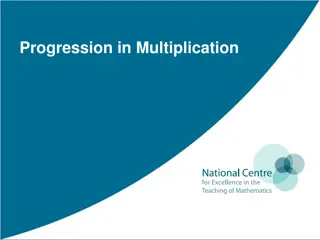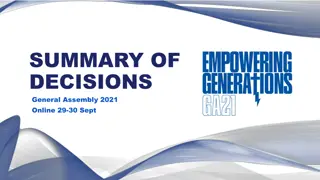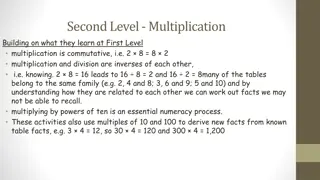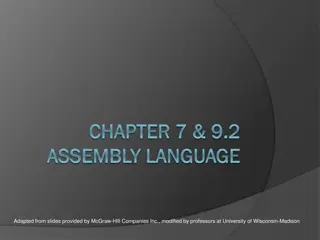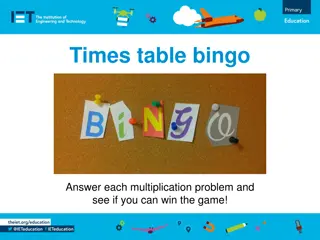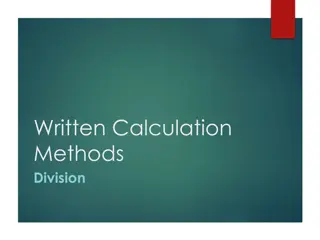Multiplication and Division Instructions in Assembly Language
Explore the concepts of multiplication and division instructions in assembly language, including MUL, IMUL, DIV, and IDIV operations. Learn about word and byte division, how to perform these operations using registers, memory, and variables, and understand the terminology and procedures involved. Dive into examples of translating high-level language statements into assembly code and see practical applications such as dividing 1250 by 7.
Download Presentation

Please find below an Image/Link to download the presentation.
The content on the website is provided AS IS for your information and personal use only. It may not be sold, licensed, or shared on other websites without obtaining consent from the author.If you encounter any issues during the download, it is possible that the publisher has removed the file from their server.
You are allowed to download the files provided on this website for personal or commercial use, subject to the condition that they are used lawfully. All files are the property of their respective owners.
The content on the website is provided AS IS for your information and personal use only. It may not be sold, licensed, or shared on other websites without obtaining consent from the author.
E N D
Presentation Transcript
Assembly Language Part VII Multiplication and Division Instructions Department of Computer Science, Faculty of Science, Chiang Mai University
Outline Multiplication and Division Instructions The Stack Organization Terminology of Procedures Decimal Input and Output Procedures 2 204231: Computer Organization and Architecture
MUL and IMUL MUL IMUL AX = Source AL DX:AX = Source AX Source may be a byte/word register or memory byte/word, but not a constant. Source Source ; multiplication ; integer multiplication 3 204231: Computer Organization and Architecture
Translate the high-level language assignment statement A = 5 A 12 B into assembly code. Let A and B be word variables, and suppose there is no overflow. Use IMUL for multiplication. MOV IMUL MOV MOV IMUL SUB AX, 5 A A, AX AX, 12 B A, AX ; AX = 5 ; AX = 5 A ; A = 5 A ; AX = 12 ; AX = 12 B ; A = 5 A 12 B 4 204231: Computer Organization and Architecture
DIV and IDIV DIV IDIV AX Divisor = AL + AH Divisor DX:AX Divisor = AX + DX Divisor Divisor may be a byte/word register or memory byte/word, but not a constant. Divisor Divisor ; divide ; integer divide 5 204231: Computer Organization and Architecture
Word Division 1. For DIV, DX should be cleared. 2. For IDIV, DX should be made the sign extension of AX. The instruction CWD (convert word to doubleword) will do the extension. 6 204231: Computer Organization and Architecture
Divide 1250 by 7. MOV CWD MOV IDIV AX, 1250 ; AX gets dividend ; Extend sign to DX BX, 7 ; BX has divisor BX ; AX gets quotient, ; DX has remainder. 7 204231: Computer Organization and Architecture
Byte Division 1. For DIV, AH should be cleared. 2. For IDIV, AH should be made the sign extension of AL. The instruction CBW (convert byte to word) will do the extension. 8 204231: Computer Organization and Architecture
Divide the signed value of the byte variable XBYTE by 7. MOV CBW MOV IDIV AL, XBYTE ; AL has dividend ; Extend sign to AH BL, 7 ; BL has divisor BL ; AL has quotient, ; AH has remainder. 9 204231: Computer Organization and Architecture
The Stack Organization LIFO: Last In First Out Top of the Stack A stack of Potato Chips PUSH Source To add a new word to the stack POP Destination To remove the top item from the stack 10 204231: Computer Organization and Architecture
The Stack Organization Source is a 16-bit register or memory word. Destination id a 16-bit register (except IP) or memory word. 11 204231: Computer Organization and Architecture
Procedure Declaration name ; body of the procedure RET name ENDP PROC type (NEAR or FAR) INCLUDE filespec CALL name 12 204231: Computer Organization and Architecture
Write a procedure FACTORIAL that will compute N! for a positive integer N. The procedure should receive N in CX and return N! in AX. Suppose that overflow does not occur. The definition of N! is N! = 1 if N = 1 = N (N 1) (N 2) 1 if N > 1 13 204231: Computer Organization and Architecture
Here is an algorithm: product = 1 term = N FOR N times DO product = product term term = term 1 END FOR 14 204231: Computer Organization and Architecture
It can be coded as follows: FACTORIAL PROC ; compute N! ; input: ; output: CX = N AX = N! MOV AX, 1 ; AX holds product TOP: ; product = product term MUL CX LOOPTOP RET FACTORIAL ENDP 15 204231: Computer Organization and Architecture
Algorithm for Decimal Output 1. IF AX < 0 2. THEN 3. 4. 5. END_IF 6. Get the digits in AX s decimal representation 7. Convert these digits to characters and print them /* AX holds output value */ print a minus sign replace AX by its two s complement 16 204231: Computer Organization and Architecture
To get the digits in the decimal representation Divide 24618 by 10. Quotient = 2461, remainder = 8 Divide 2461 by 10. Quotient = 246, remainder = 1 Divide 246 by 10. Quotient = 24, remainder = 6 Divide 24 by 10. Quotient = 2, remainder = 4 Divide 2 by 10. Quotient = 0, remainder = 2 17 204231: Computer Organization and Architecture
Line 6 count = 0 REPEAT divide quotient by 10 push remainder on the stack count = count + 1 UNTIL quotient = 0 /* will count decimal digits */ 18 204231: Computer Organization and Architecture
Line 7 FOR count times DO pop a digit from the stack convert it to a character output the character END_FOR 19 204231: Computer Organization and Architecture
Decimal Input Algorithm Print a question mark total = 0 negative = false Read a character CASE character OF - : negative = true - : read a character + : read a character END_CASE 20 204231: Computer Organization and Architecture
Decimal Input Algorithm REPEAT IF character is not between 0 and 9 THEN go to beginning ELSE convert character to a binary value total = 10 x total + value END_IF read a character UNTIL character is a carriage return 21 204231: Computer Organization and Architecture
Decimal Input Algorithm IF negative = true THEN total = -total END_IF 22 204231: Computer Organization and Architecture
An input of 123 is processed as follows: total = 0 read 1 convert 1 to 1 total = 10 x 0 + 1 = 1 read 2 convert 2 to 2 total = 10 x 1 + 2 = 12 read 3 convert 3 to 3 total = 10 x 12 + 3 = 123 23 204231: Computer Organization and Architecture
Reference Ytha Yu and Charles Marut, Assembly Language Programming and Organization of the IBM PC. New York: McGraw-Hill, 1992. 24 204231: Computer Organization and Architecture
